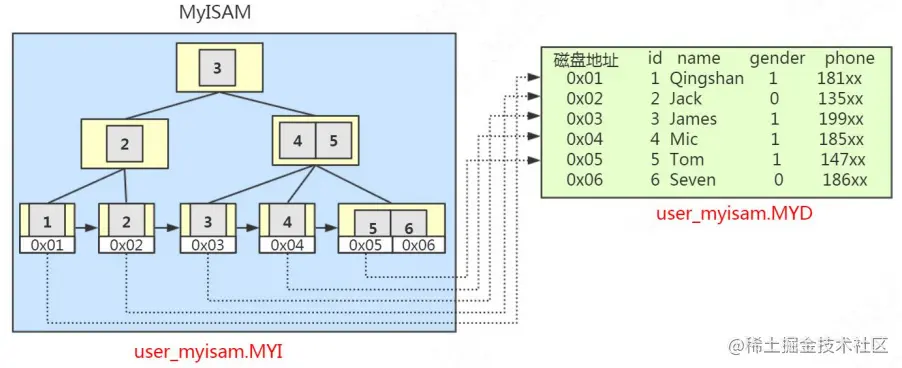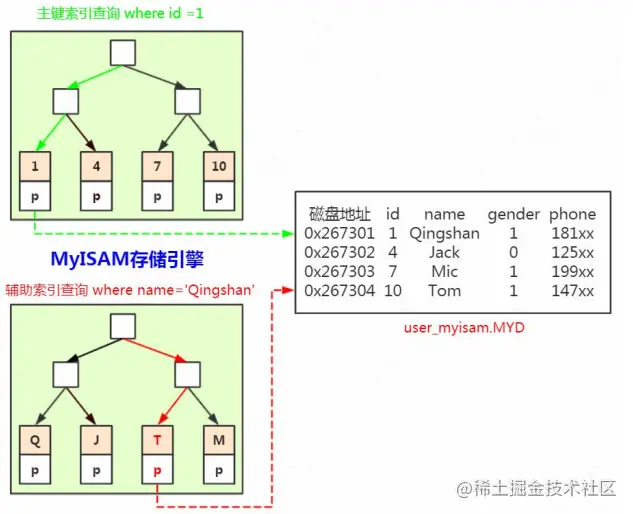A brief analysis of indexes in MySQL storage engine
This article will talk to you about how to implement indexes in the MySQL storage engine. I hope it will be helpful to you!

We know that different storage engine files are different. We can view the data file directory:
show VARIABLES LIKE 'datadir';
Each InnoDB table has two files (.frm and .ibd), MyISAM tables have three files (.frm, .MYD, .MYI). [Related recommendations: mysql video tutorial]
has the same file, .frm. .frm is the file that defines the table structure in MySQL. It will be generated no matter which storage engine you choose when creating the table, so we will not look at it.
We mainly look at how the other two files implement the indexes of different MySQL storage engines.
Let’s take a look at MyISAM first.
MyISAM
In MyISAM, there are two other files:
One is the .MYD file, D stands for Data , is the data file of MyISAM, which stores data records, such as all table data of our user_myisam table.
One is the .MYI file. I stands for Index, which is the index file of MyISAM. It stores the index. For example, if we create a primary key index on the id field, then the primary key index is in this index. inside the file.
In other words, in MyISAM, the index and data are two independent files. So how do we find the data based on the index?
In the B Tree of MyISAM, the leaf nodes store the disk addresses corresponding to the data files. Therefore, after finding the key value from the index file .MYI, the corresponding data record will be obtained from the data file .MYD.

What is drawn here is the primary key index. If it is an auxiliary index, what is the difference?
In MyISAM, the auxiliary index is also in this .MYI file. There is no difference between the auxiliary index and the primary key index in the way they store and retrieve data. They also find the disk address in the index file and then obtain the data in the data file.

InnoDB
InnoDB has only one file (.ibd file), so where is the index placed?
In InnoDB, it uses the primary key as the index to organize data storage, so the index file and the data file are the same file, both in the .ibd file.
On the leaf node of InnoDB's primary key index, it directly stores our data.

#What is a clustered index (clustered index)?
means that the logical order of the index key values is consistent with the physical storage order of the table data rows. (For example, the dictionary directory is sorted by Pinyin, and the content is also sorted by Pinyin. This directory sorted by Pinyin is called a clustered index).
In InnoDB, the way it organizes data is called a (clustered index organize table), so the primary key index is a clustered index, and the non-primary keys are non-clustered indexes.
How do indexes other than the primary key, such as the ordinary index we build on the name field, store and retrieve data?

In InnoDB, there is a primary and secondary distinction between primary key indexes and auxiliary indexes.
The auxiliary index stores the auxiliary index and primary key values. If you use an auxiliary index to query, the primary key index will be queried based on the primary key value, and the data will finally be obtained.
For example, if we use the name index to query name= '青山', it will find the primary key value in the leaf node, that is, id=1, and then go to the leaf node of the primary key index to get the data.
Another question, what if a table does not have a primary key?
1. If we define a primary key (PRIMARY KEY), then InnoDB will select the primary key as the clustered index.
2. If the primary key is not explicitly defined, InnoDB will select the first unique index that does not contain a NULL value as the primary key index.
3. If there is no such unique index, InnoDB will choose the built-in 6-byte long ROWID as the hidden clustered index, which will increment the primary key as row records are written.
select _rowid name from t2;
So? There can be no table without a primary key.
Summary
Through the above analysis, we know what the specific implementation form of indexes is in the two major storage engines, MyISAM and InnoDB.
For more programming-related knowledge, please visit: Introduction to Programming! !
The above is the detailed content of A brief analysis of indexes in MySQL storage engine. For more information, please follow other related articles on the PHP Chinese website!

Hot AI Tools

Undresser.AI Undress
AI-powered app for creating realistic nude photos

AI Clothes Remover
Online AI tool for removing clothes from photos.

Undress AI Tool
Undress images for free

Clothoff.io
AI clothes remover

Video Face Swap
Swap faces in any video effortlessly with our completely free AI face swap tool!

Hot Article

Hot Tools

Notepad++7.3.1
Easy-to-use and free code editor

SublimeText3 Chinese version
Chinese version, very easy to use

Zend Studio 13.0.1
Powerful PHP integrated development environment

Dreamweaver CS6
Visual web development tools

SublimeText3 Mac version
God-level code editing software (SublimeText3)

Hot Topics
 1386
1386
 52
52
 MySQL: Simple Concepts for Easy Learning
Apr 10, 2025 am 09:29 AM
MySQL: Simple Concepts for Easy Learning
Apr 10, 2025 am 09:29 AM
MySQL is an open source relational database management system. 1) Create database and tables: Use the CREATEDATABASE and CREATETABLE commands. 2) Basic operations: INSERT, UPDATE, DELETE and SELECT. 3) Advanced operations: JOIN, subquery and transaction processing. 4) Debugging skills: Check syntax, data type and permissions. 5) Optimization suggestions: Use indexes, avoid SELECT* and use transactions.
 How to open phpmyadmin
Apr 10, 2025 pm 10:51 PM
How to open phpmyadmin
Apr 10, 2025 pm 10:51 PM
You can open phpMyAdmin through the following steps: 1. Log in to the website control panel; 2. Find and click the phpMyAdmin icon; 3. Enter MySQL credentials; 4. Click "Login".
 MySQL: An Introduction to the World's Most Popular Database
Apr 12, 2025 am 12:18 AM
MySQL: An Introduction to the World's Most Popular Database
Apr 12, 2025 am 12:18 AM
MySQL is an open source relational database management system, mainly used to store and retrieve data quickly and reliably. Its working principle includes client requests, query resolution, execution of queries and return results. Examples of usage include creating tables, inserting and querying data, and advanced features such as JOIN operations. Common errors involve SQL syntax, data types, and permissions, and optimization suggestions include the use of indexes, optimized queries, and partitioning of tables.
 How to use single threaded redis
Apr 10, 2025 pm 07:12 PM
How to use single threaded redis
Apr 10, 2025 pm 07:12 PM
Redis uses a single threaded architecture to provide high performance, simplicity, and consistency. It utilizes I/O multiplexing, event loops, non-blocking I/O, and shared memory to improve concurrency, but with limitations of concurrency limitations, single point of failure, and unsuitable for write-intensive workloads.
 Why Use MySQL? Benefits and Advantages
Apr 12, 2025 am 12:17 AM
Why Use MySQL? Benefits and Advantages
Apr 12, 2025 am 12:17 AM
MySQL is chosen for its performance, reliability, ease of use, and community support. 1.MySQL provides efficient data storage and retrieval functions, supporting multiple data types and advanced query operations. 2. Adopt client-server architecture and multiple storage engines to support transaction and query optimization. 3. Easy to use, supports a variety of operating systems and programming languages. 4. Have strong community support and provide rich resources and solutions.
 MySQL's Place: Databases and Programming
Apr 13, 2025 am 12:18 AM
MySQL's Place: Databases and Programming
Apr 13, 2025 am 12:18 AM
MySQL's position in databases and programming is very important. It is an open source relational database management system that is widely used in various application scenarios. 1) MySQL provides efficient data storage, organization and retrieval functions, supporting Web, mobile and enterprise-level systems. 2) It uses a client-server architecture, supports multiple storage engines and index optimization. 3) Basic usages include creating tables and inserting data, and advanced usages involve multi-table JOINs and complex queries. 4) Frequently asked questions such as SQL syntax errors and performance issues can be debugged through the EXPLAIN command and slow query log. 5) Performance optimization methods include rational use of indexes, optimized query and use of caches. Best practices include using transactions and PreparedStatemen
 MySQL and SQL: Essential Skills for Developers
Apr 10, 2025 am 09:30 AM
MySQL and SQL: Essential Skills for Developers
Apr 10, 2025 am 09:30 AM
MySQL and SQL are essential skills for developers. 1.MySQL is an open source relational database management system, and SQL is the standard language used to manage and operate databases. 2.MySQL supports multiple storage engines through efficient data storage and retrieval functions, and SQL completes complex data operations through simple statements. 3. Examples of usage include basic queries and advanced queries, such as filtering and sorting by condition. 4. Common errors include syntax errors and performance issues, which can be optimized by checking SQL statements and using EXPLAIN commands. 5. Performance optimization techniques include using indexes, avoiding full table scanning, optimizing JOIN operations and improving code readability.
 Monitor Redis Droplet with Redis Exporter Service
Apr 10, 2025 pm 01:36 PM
Monitor Redis Droplet with Redis Exporter Service
Apr 10, 2025 pm 01:36 PM
Effective monitoring of Redis databases is critical to maintaining optimal performance, identifying potential bottlenecks, and ensuring overall system reliability. Redis Exporter Service is a powerful utility designed to monitor Redis databases using Prometheus. This tutorial will guide you through the complete setup and configuration of Redis Exporter Service, ensuring you seamlessly build monitoring solutions. By studying this tutorial, you will achieve fully operational monitoring settings




